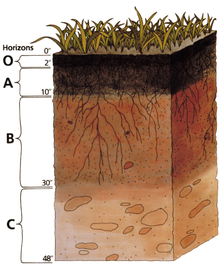
Soil is an important part of the earth’s ecosystem whether we are looking at McLeod Ganj, Tibet, or anywhere else in the world: the same principles apply. A good quality of the ground is crucial for the growth of plants and the existence of our diverse nature. It is therefore important to understand what soil is – and how we can protect this life-giving resource.
Soil is a mixture of minerals, organic matter and voids. These voids make up about 50% of the soil and are filled with water and gasses.But depending on the depth, many characteristics of the ground change. Scientists have distinguished several layers – called “Horizons“ –each one important for different reasons.
Horizons O and A arecalled topsoil. These are the layers in which seeds germinate and the plants grow. The roots might also reach into the subsoil underneath which contains mineral deposits from the upper layers. This makes the Horizons O,A and B of special interest to farmers.
Plantsusually don’t enter the layer below – Horizon C. It consistsof slightly broken-up bedrock which becomes unweathered further down.Engineers focus on this depth,as the bedrock has to carry building foundations or roads.
But engineers are becoming increasingly interested in the upper layers and preventing their erosion. Erosion happens naturally,but humans often accelerate this process through improper use of the ground. And it causes the loss of a valuable resource: resources that could be used for farming or protecting building foundations. A good Erosion and Sediment control (E&SC) is therefore a necessity.
The topsoil from construction sites can easily be saved and reused for stabilising roads and growing plants. This is standard practice in E&SC. It adds costs but ensures good infrastructure that will last for many years.
An example of E&SC playing an important role can be found among the Gaddi farmers of Kareri village near McLeod Ganj. Over hundreds of years, they have made flat terraces to minimise soil loss of Horizons O, A &B. Their crops and lives depend on E&SC.
Soils management should follow the “waste” diagram (see our previous Contact article Reducing Waste and Material use). Prevention is better than reuse, which is better than disposal.We depend on a good quality of the ground. And because of that we should treat soil as a valuable resource.




 Print
Print Email
Email